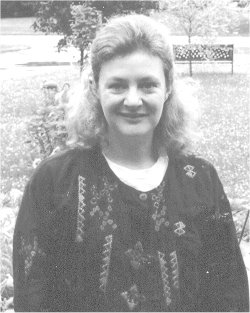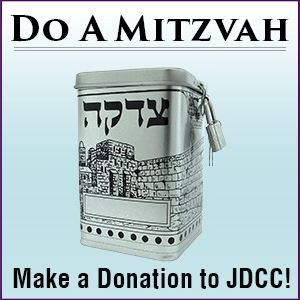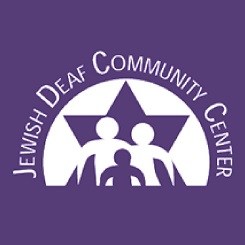
Cassia Margolis
Jewish Heritage and Holidays in ASL
629 Golf Lane
Indianapolis, IN 4626-4112
[email protected]
(317)1726-1266 V/TTY
Cassia Margolis Fills Need
From Personal Experience
Four years ago, Ann Cassia Margolis incorporated `Jewish Heritage and Holidays’ (JHAH) as a non-profit organization to produce and distribute videos on Judaism presented in sign language. She explains that the organization fills a need that became apparent from her personal experience in the Margolis family and with her own family.
Born in a hearing family, she has two sisters and a brother. The youngest sister is Deaf. “I grew up hearing, and still consider myself Hearing,” Ann says, “although I am technically hard-of-hearing. I woke up one morning, a few years ago, and couldn’t hear out of my right ear. Then, some months later, the hearing in my left ear suddenly ‘dropped’, although I can still follow most conversation I struggle in using the telephone and have a lot of trouble hearing children’s and some women’s voice. There is no ‘known’ reason for my hearing loss…”
“While growing up, however, I heard from relatives that the Margolis women all became deaf or hard-of-hearing…” She mentioned one cousin Ruth Lee who became hard-of-hearing, her grandmother who was hard-of-hearing from birth, and others like his aunt or cousin Rochelle who went hard-of-hearing or deaf at a later age. “Few men are affected, although, Rochelle’s brother became suddenly deaf as a young teenager” she add, “Since almost all of the family began life ‘hearing’, they stayed oral, and until my sister. Shana, was born Deaf, no one ever used sign language.”
“There are positives and negatives to a family like this. The positive is that you don’t get `upset’ by losing your hearing. You grow up knowing and loving a whole bunch of relatives who don’t hear very well. BUT the negative part is that they all ‘deny’ it-‘I have a little trouble hearing’ is a typical statement…”
Coping With Sign Language And Judaism
“It is partly because of that struggle, and how, reluctantly, my father and step-mother were to finally allow her [Shana] to sign, that I opted, as the first method used with my son and daughter, who are pre-lingually deaf, to use sign language…”
Ann Cassia Margolis and her husband currently have three children. “Our oldest daughter, Esther (14 years old) is hearing, our son (Aaron) and younger daughter (Sarah) are deaf. Although, in the last few years, our sons hearing has started to fluctuate, sometimes wildly, and his better ear has inched into the `hard-of hearing’ range – so it is hard for me to be sure how to label him. Even before this change in his hearing. Our son – who had spent 3 years in the BiBi program at the Indiana School for the Deaf, decided to become oral, and attends a regular afternoon Hebrew school program, and a Shabbat boy’s class without an interpreter. In the public school, he is in 5th grade and is on the honor roll. While he struggles more with Hebrew than he would if he were hearing, we have relatively few worries about his accessing a thorough Jewish education. However, our daughter is a person who is sure that all of the Hearing people that she knows are totally jealous of her being deaf and she accesses information through ASL- and that is where the big hole – the Big Black Hole in the area of Jewish educational materials.”
Lack of Jewish Materials For Deaf
“One of the disadvantages of going with ASL, is the lack of materials available for providing a Jewish education. When we first started looking for materials for my son, we were shocked to find how little was available. In our entire state, there were no Jewish interpreters, no interpreted services or classes, no classes offered in ASL, no Jewish Deaf organizations, and no way to access any resources. My husband and I set out trying to dig up anything, anything at all. We found a book of Jewish signs, but it didn’t reflect our regional ASL, we found a book on `Celebrating Judaism in the Home’ and we became members of Our Way, which had no chapter in our state, but allowed us to attend national programs where our son could be exposed to other Jewish Deaf. Gradually, we began a Jewish Deaf ‘group’, in Indianapolis – and this later became affiliated with Our Way.
“A few years ago, we were discussing starting a class for the dozen Jewish deaf children here in Indianapolis. We had a synagogue that would let us use their building, but we weren’t sure if we could keep it going. It is hard to get parents to drive in, once a week, or every other week, and hard to plan what to teach with no ASL materials available. At an Our Way hamantaschen baking party at our home, just before Purim, Beatrice Pfaff got up to tell the story of Purim. Watching her tell the story, I suddenly realized that we should be videotaping this, and I ran to get my camcorder. Afterwards, my husband, Bea and I discussed if it would be possible to do a series of Jewish educational videotapes in ASL. We realized that if we had a set of tapes, this could be the material for a class, or even for parents to do their own teaching with their child. Whether or not the parents signed well, or if they signed well, but hadn’t gotten much of a Jewish education themselves- the barrier to access of educational materials could be removed. It also meant that instead of just focusing on a school program to benefit our local kids, we could enable the one Jewish boy we knew of in Cincinnati, or the young woman in San Antonio, Texas the only Jewish Deaf person in her city – to also benefit from this.
“At about this time, my father died. This might sound like it would put a damper on the project, but it did the opposite. From a religious point of view, many family members use the time of the year after the person’s death to do a mitzvah or tzedakah project in the name of the deceased. So, funding the first tape became my project, to honor my father’s memory. It was a very appropriate project, too, because after he and my stepmother understood that my sister would be signing, they went to a lot of effort and expense to make sure that she had interpreters for synagogue, for Sunday school, and that she was able to participate in programs like Camp Kesher (run by Ramah).
“Bea and I used a studio and camera that were part of a distance-learning program, for this first tape. Since we weren’t sure how feasible this entire project would be, we decided to stick with “Purim”- a relatively short topic that Bea had already presented a couple of times. Well, it was quite a lesson. It took many, many hours – and we had to toss out a lot of attempts to come up with a tape that is slightly less than 15 minutes, and still has a couple of errors in it. But we did it, and we had 200 copies made and then set out to try to distribute them.”
To date JHAH has produced nine videos:
Tape One: Purim
Tape Two: Passover
Tape Three: The Holocaust/ An Interview with Samuel Landau
Tape Four: Simon Carmel : The Holocaust/ A Deaf Perspective
Tape Five: David L. Bloch – Holocaust Survivor and Artist Tape Six: Food Brachot and the Meaning of the Shma
Tape Seven: What is the Meaning of Kosher Sex? Having Jewish Values in a Relationship Tape Eight: Midrashic and Rabbinic Stories
Tape Nine: Rabbi Benztion Kravitz/ The Jewish Response to Missionaries
Ann has a Bachelor of Fine Arts in painting and printmaking from the University of Pennsylvania, a Masters degree from the University of Wisconsin-Milwaukee, and an M.F.A. in painting from Brooklyn College. “I also have done some post-graduate work the University of Cincinnati.”
Hopes JHAH Videos To Benefit
In a cover letter Cassia Margolis and Larry Greenbaum wrote to accompany their first video on July 29, 1999 states “The videotape project grew out of the desire to provide all of our children with access to a Jewish education. Not only our children for whom English was easily accessible, but also for those whose language of instruction is ASL. We had discussed trying to offer a signed Shabbat or Sunday school program, but felt that it would be almost impossible to keep it running for more than a year. Interpreting a classroom that was already set up would probably make the material very dry for all but the oldest children, and either classroom option would only help our local children…”
In reviewing the letter that goes with each videotape, you could see support they enlisted from various people and organizations to make production of each video possible. Copies of each JHAH video is available free of charge to Jewish Deaf, parents of Jewish Deaf children, and programs providing services to Jewish Deaf. Others interested in obtaining copies may purchase them at cost. “Because our funding is very limited, we appreciate any donations towards the cost of the tapes, and we also have opportunities available for anyone wishing to sponsor a videotape. We are also always seeking presentations in ASL that would add to the body of Jewish knowledge available to those who use sign.”





